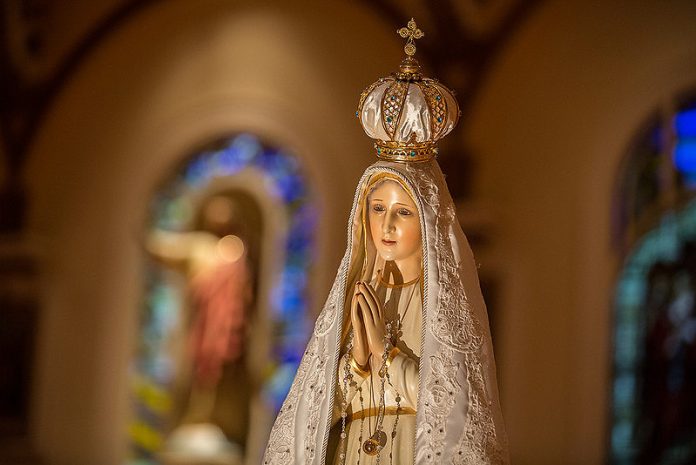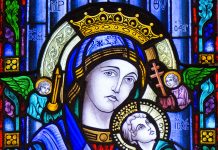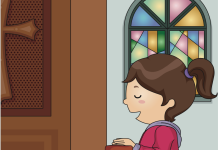
By Virginia M. Kimball
Pray, fast, confess, receive the Eucharist, and be devoted to the Immaculate Heart
One hundred years ago, in 1917, three years into World War I, the world was in chaos. Christianity was being attacked from all sides by atheists and secular anti-church movements. The month was May, and Pope Benedict XV, moved by profound worry, sent out a petition to all Catholic bishops, asking for a litany of prayer to the Virgin Mary, whom he deemed “the Queen of Peace.” Only eight days later, on May 13, remarkable apparitions of Our Lady began in a remote area of Portugal. Mary, the mother of Christ, came to three shepherd children. Their lives were simple but filled with hope and unbreakable faith. They would be forever changed by Mary’s message.
Prepared by an angel
The children — Francisco Marto (age 9), Jacinta Marto (age 7), and Lucia Santo (age 10), were first prepared in 1916 by the mystical appearances of three angels, who came to them in a rocky grotto on the side of Mount Cabeco. There the children clustered daily, near their sheep, to pray the Rosary. The first angel comforted them and announced that he was the “Angel of Peace.” He taught them a prayer, known today around the world: “My God, I believe in You, I hope in You, I adore and love You. I ask pardon for all who do not believe, who do not hope in You, who do not adore nor love You.” Now, 100 years later, isn’t this an important prayer for today?
Later in the summer the “Angel of Portugal” appeared to the children beside a spring. They were then instructed that it was necessary to offer up unending prayers and sacrifices … for the rest of their lives! In autumn of 1916, a third angel appeared to them offering the Eucharist, with a special prayer. In this petition to Jesus, begging for the reparation of outrages, sacrileges, and the indifference of mankind, they were taught to appeal to the Sacred Heart of Christ and the Immaculate Heart of Mary.
The appearances of Mary
After these angelic visitations, in May 1917 the children were once again tending their flocks. They gathered to pray at the Cova da Iria. It was there that they witnessed a beautiful lady above the top of a small holm oak tree. She told them that she would meet with them at this location on the 13th day of each month until October. In this manner the children were gradually introduced to the fact that this was the mother of Jesus coming to them. This tender mother indicated that they would have sorrows and sufferings, showing them that they were to play a role in helping the world to know true peace. They were to serve Jesus by making the Virgin Mary better known and encourage a devotion to her Immaculate Heart.
While the children experienced great trials from family, friends, and even their priest due to their claims of seeing the lovely lady on the oak tree, the Virgin promised them a great miracle that many people would see. Three months in advance, she told them it would occur on October 13, 1917.
The miracle of the sun
When October 13 came, more than 60,000 people, having heard about the children’s beautiful lady, formed a crowd at the Cova da Iria. Rain-soaked, the crowds stood in a muddy field awaiting something … they knew not what. But then, suddenly the rain cleared and the sun appeared in a blinding brilliance, revolving like a spinning wheel of fire. The crowd dried off as the sun appeared to dance in the sky. During this time, the children saw four important sights near the sun: Mary with the rosary and Joseph holding the infant Jesus; Jesus in his manhood, blessing them and all the world; Mary as a mother of sorrow; and lastly, Mary as the Lady of Mt. Carmel holding the brown scapular.
Previously, before the great miracle of the sun occurred, the beautiful lady had shown the children a brief sight of hell. It was momentary but terrifying. Lucia later described hell to be an immense sea of fire that reaches to the center of the earth, filled with demons and lost human souls. Bystanders heard Lucia cry out with a heart-wrenching “Oh!” Lucia later explained that prayer is needed to save others from this fate, particularly devotion to the Immaculate Heart of Mary.
The Immaculate Heart of Mary
Throughout the accounts of the monthly apparitions of the Virgin Mary to the children, we hear a strong injunction for devotion to the Immaculate Heart of Mary. What does this mean? Now, 100 years later, we still see a violent world around us. People have little or no regard for human life. This disregard is seen in abortions, terrorism, senseless shootings, rampant crime, and worldwide attacks on Christian churches of all denominations. The lesson taught to the Fatima children is still of core importance. The Virgin Mary called them to teach the hurting world to pray, fast, confess, and receive the Eucharist. When we recall the remarkable events of Mary coming to the children in Cova da Iria, leading up to the great day of the miracle of the sun, the situation is still the same. The children reported that the Virgin was saddened by hardness and sin in the world because it disappointed and insulted her Son.
Mary’s words should still ring in our ears. We must still have love and connection with her “immaculate heart.” But what does that mean?
Francisco and Jacinta died soon after the apparitions. As the Virgin had promised them, they were taken to joy and happiness in heaven. During their short lives they practiced severe self-denials and suffering. Their illnesses were periods of trial. But in their deaths, these two children taught the true meaning of life — to live for Jesus and to place one’s heart into the heart of Christ’s mother where they would be united to Christ with joy and hope even in their sufferings. St. John Paul II beatified Francisco and Jacinta Marto on May 13, 2000.
Lucia lived a long but secluded life as a religious. Later, at the direction of her spiritual adviser and the bishop, she did write down many of her memories (with hesitation because she knew the details might be misunderstood and detract from the real message). She died in 2005, and the cause for her canonization is underway.
Today millions visit the Shrine of Fatima and find their lives blessed by such a pilgrimage. While pilgrimages to celebrate Fatima’s centennial are coming from all over the world, true fervor can rise up right at home where we are. Dedication to the “immaculate heart” of Mary can be found at the center of prayer and receiving the holy Eucharist.
Many have been fascinated with the “secrets” told by the children and their possible apocalyptic meanings. In a remarkable theological commentary on the message of Fatima by Joseph Cardinal Ratzinger (who later became Pope Benedict XVI), we find answers to questions posed concerning the “secrets” so often mentioned about Fatima through the last century. Ratzinger explained that much of the content refers to things that are past. He writes:
Those who expected exciting apocalyptic revelations about the end of the world or the future course of history are bound to be disappointed. … The exhortation to prayer as the path of “salvation for souls” and, likewise the summons to penance and conversion is the most important. (Note: See the theological commentary by Joseph Cardinal Ratzinger, Prefect of the Congregation for the Doctrine of the Faith, here: CATmag.us/2igo139.)
Ratzinger said that the most famous “secret” spoken by the Virgin — “my Immaculate Heart will triumph,” — challenges us to understand what she meant. He notes that in Christian life it is the “heart” that must stay open to God and is purified by contemplation of God. When we think of Mary’s life and her fiat to accept the will of God, “the word of her heart,” we find a truth that changed the world and will bring it to salvation. He explains that biblically the heart “indicates the center of human life, the point where reason, will, temperament, and sensitivity converge, where the person finds his unity (to God) and his interior orientation.”
The heart is where we find God and unite ourselves to the presence of God and his will. The Hebrew word for heart (leb) is inextricably united to two other words used throughout the Scriptures — soul (nefesh), which means the core of God’s presence within the person, and spirit (ruah) meaning the life-giving power that enlivens the person. The Book of Proverbs teaches: “Trust in the LORD with all your heart” (Proverbs 3:5). Jeremiah the prophet instructs us: “When you look for me, you will find me. Yes, when you seek me with all your heart, I will let you find me … and I will change your lot” (Jeremiah 29:13).
It is in Mary’s most holy heart — “immaculate” because in it dwells her Son — that we can unite our hearts to God. Devotion to Mary’s Immaculate Heart as she constantly urged at Fatima is linking ourselves to Christ in his holy mother’s heart. She is holy because she totally embraces her Son in her heart, in her whole being. We, too, find Christ there.
Mary’s message for today
Why did God choose these three children to bring such a critical message to the world, then and still now 100 years later? In their unbreakable trust in the beautiful lady, they came to love the mother of their Lord. Today they still bring the truths of Christ’s way to an impoverished world. Children today must be taught to pray, especially the Rosary, like Lucia, Francisco, and Jacinta did every day. Their suffering to do God’s will was remarkable. They showed us the way to be trusting “children of the Lord.” [Editor’s note: See related articles on “Five Lessons from Fatima” on page 29, and “Not Your Average Living Rosary” on page 25.)
For all Christians today, the message is clear: Pray and fast. For the rest of their lives, the children at Fatima professed the need for devotion to Mary’s Immaculate Heart — where Christ is found. We must pray for all souls to avoid hell, not just ourselves. We must link our hearts to Mary’s heart that unites us with her Son. She is our mother, and she leads us to the peace that God will give the world when we turn to Jesus Christ, in whom we find joy and eternal life.
[SEE MORE FATIMA RESOURCES BELOW.]
Virginia M. Kimball, STD, is an adjunct professor of theology in the Career and Continuing education department at Assumption College, Worcester, Massachusetts. She is a member and past president of both the Mariological Society of America and the Ecumenical Society of the Blessed Virgin Mary.
Fatima Resources
Shrine of Fatima. The official webpage from Fatima. Chronology, primary sources, photos, historical narratives, are found at Fatima.pt/en.
EWTN. The well-known Catholic television network offers a beautiful website, “The 100th Anniversary of Fatima,” with excellent video galleries and commentary. Go to EWTN.com/Fatima. Find a comprehensive list of papal consecrations to the Blessed Virgin Mary, as well as papal preaching on Fatima over the past fifty years, at EWTN.com/fatima/popes-and-fatima.asp.
World Apostolate of Fatima. The international apostolate under the Pontifical Council for the Laity in the Roman Curia promotes the message of Fatima worldwide. See WorldFatima.com. The Apostolate has many diocesan divisions in the United States, including the St. Paul and Minneapolis Archdiocesan Division that maintains a reliable website at FatimaOnline.org.
Want to share the Fatima story with primary grades?
Dr. Kimball has written a simple narrative about the Fatima message that can be read aloud for children. Find it at: Catechist.com/fatima.




